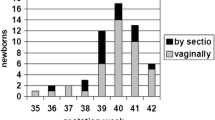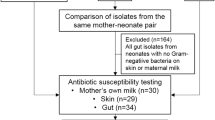Summary
Gram-negative bacteria are an important cause of invasive infection among neonates. In this study a novel fingerprinting method was used for the first time to assess the importance of various potential reservoirs of the major gram-negative enterobacteria that colonized 46 consecutive infants in three neonatal special care units during a three to four week period. Such bacteria were isolated from the oropharynx, umbilical cord and faeces in 24%, 33% and 100% of the infants, respectively.Klebsiella/Enterobacter spp. dominated overEscherichia coli and spreading (shared) over sporadic strains. Sixty-one percent of the neonates were colonized with at least one and up to six different strains shown to exist in the ward, mainly in other infants. Environmental reservoirs and the faecal flora of mothers and staff were of minor importance. Vertical transmission occurred in 12% of vaginally delivered infants and in 0% of those delivered by caesarean section.
Zusammenfassung
Gramnegative Bakterien sind wichtige Erreger invasiver Infektionen bei Neugeborenen. In der vorliegenden Studie wurde erstmals eine moderne Fingerprint-Methode eingesetzt, um die Bedeutung verschiedener möglicher Reservoirs für die Besiedelung durch Enterobakterien zu bestimmen. In drei Neugeborenen-Spezialstationen wurden während vier Wochen Untersuchungen bei 46 nacheinander aufgenommenen Neugeborenen durchgeführt. Aus dem Oropharynx, der Nabelschnur und den Faeces der Kinder wurden in 24%, 33% und 100% Enterobakterien isoliert.Klebsiella/Enterobacter spp. waren häufiger nachzuweisen alsEscherichia coli. Stämme, die sich ausgebreitet hatten, waren häufiger als sporadische Stämme. 61% der Neugeborenen waren mit bis zu sechs Stämmen besiedelt, die sich in der Stationsumgebung, vor allem aber auch bei den anderen Neugeborenen nachweisen ließen. Die Umgebung und die Stuhlflora der Mütter und des Pflegepersonals waren von geringerer Bedeutung. Eine vertikale Übertragung erfolgte bei 12% der vaginal entbundenen Neugeborenen und bei keinem der durch Sectio entbundenen Kinder.
Similar content being viewed by others
References
Tullus, K., Olsson-Liljequist, B., Lundström, G., Burman, L. G. Antibiotic susceptibility of 629 bacterial blood and CSF isolates from Swedish infants and the therapeutic implications. Acta Paediatr. Scand. 80 (1991) 205–212.
Goldmann, D. A. Bacterial colonization and infection in the neonate. Am. J. Med. 70 (1981) 417–422.
Hill, H. R., Hunt, C. E., Matsen, J. M. Nosocomial colonization withKlebsiella, type 26, in a neonatal intensive-care unit associated with an outbreak of sepsis, meningitis, and necrotizing enterocolitis. J. Pediatr. 85 (1974) 415–419.
Christensen, G. D., Korones, S. B., Reed, L., Bulley, R., McLaughlin, B., Bisno, A. L. EpidemicSerratia marcescens in a neonatal intensive care unit: importance of the gastrointestinal tract as a reservoir. Infect. Control 3 (1982) 127–133.
McAllister, T. A., Givan, J., Black, A., Turner, M. J., Kerr, M. M., Hutchinson, J. H. The natural history of bacterial colonization of the newborn in a maternity hospital (Part I). Scot. Med. J. 19 (1974) 119–124.
Lejeune, C., Bourrillon, A., Boussougnant, Y., de Paillerets, F. Sequential development of the intestinal flora in newborn infants: a quantitative differential analysis. Dev. Pharmacol. Ther. 7 (1984) (Suppl. 1) 138–143.
Graham, J. M., Taylor, J., Davies, P. A. Some aspects of bacterial colonization in ill, low birth-weight and normal newborns. In:Stern, L. (ed.): Intensive care of the newborn. Masson Publishing, New York 1976, pp. 59–72.
Tullus, K., Fryklund, B., Berglund, B., Källenius, G., Burman, L. G. Influence of age on faecal carriage of P-fimbriatedEscherichia coli and other gram-negative bacteria in hospitalized neonates. J. Hosp. Infect. 11 (1988) 349–356.
Rosner, R. Antepartum culture findings of mothers in relation to infantile diarrhea. Am. J. Clin. Pathol. 45 (1966) 732–736.
Bettelheim, K. A., Teoh-Chan, C. H., Chandler, M. E., O'Farrell, S. M., Rahamin, L., Shaw, E. J., Shooter, R. A. Spread ofEscherichia coli colonizing newborn babies and their mothers. J. Hyg. (Cambridge) 73 (1974) 383–387.
Gothefors, L., Carlsson, B., Ahlstedt, S., Hansson, L. Å, Winberg, J. Influence of maternal gut flora and colostral and cord serum antibodies on presence ofEscherichia coli in faeces of the newborn infant. Acta Paediatr. Scand. 65 (1976) 225–232.
Bettelheim, K. A., Lennox-King, S. M. J. The acquisition ofEscherichia coli by newborn babies. Infection 4 (1976) 174–179.
Sarff, L. D., McCracken Jr., G. H., Shiffer, M. S., Glode, M. P., Robbins, J. B., Ørskov, I., Ørskov, F. Epidemiology ofEscherichia coli K1 in healthy and diseased newborns. Lancet i (1975) 1099–1104.
Peter, G., Nelson, J. S. Factors affecting neonatalE. coli K1 rectal colonization. J. Pediatr. 93 (1978) 866–869.
Goldmann, D. A., Leclair, J., Macone, A. Bacterial colonization of neonates admitted to an intensive care environment. J. Pediatr. 93 (1978) 288–293.
Tullus, K., Berglund, B., Fryklund, B., Kühn, I., Burman, L. G. Influence of antibiotic therapy on faecal carriage of P-fimbriatedEscherichia coli and other gram-negative bacteria in neonates. J. Antimicrob. Chemother. 22 (1988) 563–568.
Tullus, K., Berglund, B., Fryklund, B., Kühn, I., Burman, L. G. Epidemiology of fecal strains of the familyEnterobacteriaceae in 22 neonatal wards and influence of antibiotic policy. J. Clin. Microbiol. 26 (1988) 1166–1170.
Borderon, J. C., Gold, F., Laugier, J. Enterobacteria of the neonate. Normal colonization and antibiotic-induced selection. Biol. Neonate 39 (1981) 1–7.
Kühn, I. Biochemical fingerprinting ofEscherichia coli: a simple method for epidemiological investigations. J. Microbiol. Methods 3 (1985) 159–170.
Kühn, I., Burman, L. G., Eriksson, L., Möllby, R. Subtyping ofKlebsiella by biochemical fingerprinting: a simple system for epidemiological investigations. J. Microbiol. Methods 11 (1990) 177–185.
Fryklund, B., Tullus, K., Burman, L. G. Epidemiology of enteric bacteria in neonatal units — influence of procedures and patient variables. J. Hosp. Infect. 18 (1991) 15–21.
Goldmann, D. A. The bacterial flora of neonates in intensive care — monitoring and manipulation. J. Hosp. Infect. 11 (1988) 340–351.
Goldmann, D. A. Prevention and management of neonatal infections. Infect. Dis. Clin. North Am. 3 (1989) 779–813.
Author information
Authors and Affiliations
Rights and permissions
About this article
Cite this article
Fryklund, B., Berglund, B., Burman, L.G. et al. Importance of the environment and the faecal flora of infants, nursing staff and parents as sources of Gram-negative bacteria colonizing newborns in three neonatal wards. Infection 20, 253–257 (1992). https://doi.org/10.1007/BF01710789
Received:
Accepted:
Issue Date:
DOI: https://doi.org/10.1007/BF01710789




